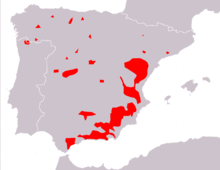Iberian ibex
| Iberian ibex | ||||||||||||
|---|---|---|---|---|---|---|---|---|---|---|---|---|

Iberian ibex ( Capra pyrenaica victoriae ) |
||||||||||||
| Systematics | ||||||||||||
|
||||||||||||
| Scientific name | ||||||||||||
| Capra pyrenaica | ||||||||||||
| Schinz , 1838 |
The Iberian ibex ( Capra pyrenaica ) is a species of goat that is widespread in the Iberian Peninsula . Despite the outwardly quite clear differences, it is genetically similar to the Alpine Ibex and, according to recent studies, may even belong to the same species.
Appearance
The Iberian ibex looks smaller and more delicate than the Alpine ibex . Its head body length is 100 to 140 cm, its shoulder height 65 to 75 cm and the weight is around 40 kg (females) or 80 kg (bucks). The fur is light brown in color and resembles that of the Bezoar goat . In summer it is light to red brown. The horns of the Iberian ibex are shaped differently than those of the Alpine ibex. It becomes up to 75 cm long in the buck. They curve first outwards and upwards, later back inwards, and have a sharp rear edge. The goat has only short, hardly curved horns.
Distribution area and subspecies

The original distribution area was the Pyrenees and several mountain ranges in Spain and Portugal . Today it has shrunk a lot from heavy hunting, which is why the entire species is potentially endangered. Four subspecies are distinguished, two of which are extinct. The Portuguese ibex ( C. p. Lusitanica ) was exterminated as early as 1890.
The Pyrenean Ibex ( C. p. Pyrenaica ) was exterminated on the French side of the Pyrenees in the 19th century; In the 1980s there were still 30 animals on the Spanish side, in the 1990s the number fell further; the last living specimen, a female, died on January 6, 2000, making the subspecies extinct. Since the population was strictly protected and guarded, the reasons for the extinction are puzzling; a susceptibility to infections originating from cattle and goat herds is assumed. Attempts to bring this subspecies back to life by cloning have so far failed. In 2013, however, common ibexes were reintroduced in the French Pyrenees, 40 animals each in the area of the Pyrenees National Park and in the area of Mont Valier in the Ariège .
The two other subspecies are reasonably certain: C. p. hispanica from south-east Spain counts about 8000 specimens. The Gredos ibex ( C. p. Victoriae ) from central Spain was exterminated in 1905 with the exception of twelve animals; but they were strictly protected and today they could multiply again to a population of 3500. Since this population is still not really secured, the subspecies is still considered endangered.
Way of life
Like other ibex and wild goats, the species inhabits rocky or mountainous terrain. In terms of lifestyle and diet, the species hardly differs from the Alpine Ibex. Like this, it feeds on grasses, herbs and leaves. The mating season falls between November and January. During this time the animals live in mixed groups of about ten animals, which consist of goats and goats. From February the old goats leave these groups. In April, when the pregnant females give birth to their young, the teenagers also leave the groups. In autumn, larger, mixed herds will form again. The gestation period is six months and ends in May with the birth of a young animal ( fawn ), in rare cases also twins.
photos
Iberian Ibex in the San Diego Zoo
Young of the Gredos ibex in the Sierra de Gredos
literature
- Ronald M. Nowak: Walker's Mammals of the World . Johns Hopkins University Press, 1999 ISBN 0-8018-5789-9
- David Macdonald: The Great Encyclopedia of Mammals. Könemann Verlag in Tandem Verlag GmbH, Königswinter, 2004.
Individual evidence
- ^ Phylogenetic Reconstructions in the Genus Capra (Bovidae, Artiodactyla) Based on the Mitochondrial DNA Analysis . Russian Journal of Genetics, 2007, vol. 43, no. 2, pp. 181-189. doi: 10.1134 / S1022795407020135
- ↑ The bouquetin sera réintroduit en 2013 in the Pyrénées . La Depeche, online report of October 27, 2012. [1]
Web links
- The type specimen of the Pyrenean ibex at the Natural History Museum in Mainz
- Capra pyrenaica in the endangered Red List species the IUCN 2006. Posted by: Caprinae Specialist Group, 1996. Retrieved on 8 May, 2006.





